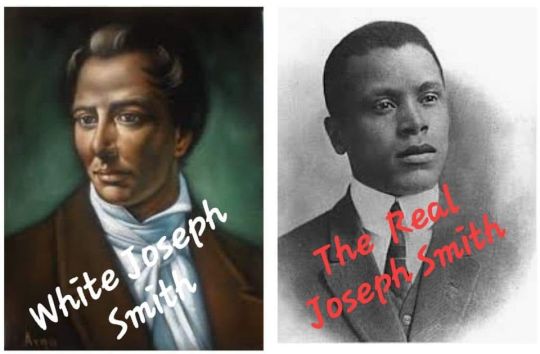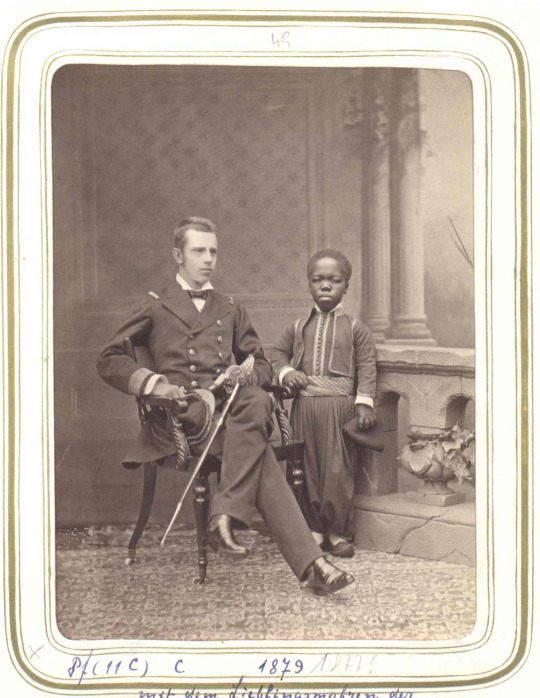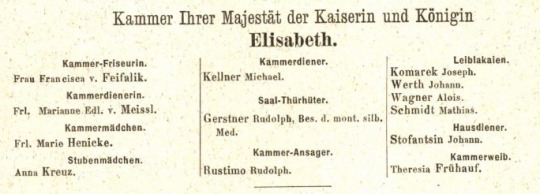#Blackamoor
Text

#kevinwakswilliams#kevin wak williams#black art#free your mind#dr ivan van sertima#dr frances cress welsing#blackamoor#marcus garvey#moorish#moor#moors#dr joy degruy#stacy tisdale#runoko rashidi#martin luther king quotes#lois mailou jones#madam cj walker#neely fuller jr#black wall street#black panther party of self defense
57 notes
·
View notes
Text




Perfume bottle; from Womanity ebay janetcdp
8 notes
·
View notes
Text
Robert Lacey was determined to push the BREXIT angle using MegaLiar's REVENGE on Lady Susan Hussey & Princess Michael of Kent. These guests weren't invited to Pippa's wedding reception.
They found an actor who looks nothing like Sparry. Too bad Sparry can't see how ashamed the wife is of his baldness & low IQ.

#brexit#Robert Lacey & Scarlett Lacey Lied#megxit#blackamoor#fake racism#Susan Hussey#pippa's wedding
3 notes
·
View notes
Text

Anello Moro Veneziano Cobra -Argento dorato e legno ebano
3 notes
·
View notes
Text

Cuban Social vol VI nr. 5 (mayo 1921)
#cuba#cuban#havana#habana#blackamoor#colonial cuba#1920s#1900s#1921#havana cuba#habana cuba#historical#pre revolution cuba#pre fidel cuba#cuban social
1 note
·
View note
Photo


Nettuno, Italy
0 notes
Text

Karl Bryullov (Russian, 1799-1852)
Portrait of the Volkonsky children with a blackamoor. 1843
State Tretyakov Gallery, Moscow
#Karl Pavlovich Bryullov#Karl Bryullov#Portrait of the Volkonsky children with a blackamoor#1800s#art#fine art#european art#classical art#europe#european#oil painting#fine arts#europa#russian art#russia#russian
43 notes
·
View notes
Text






#the blackadder's progress.. encyclopedia blackaddica.. landscape gardening (capability brownadder?)..#from black death to blackadder.. blackadder's bedside cockfighting companion.. blackadder book of martyrs..#the blackobite rebellion.. old blackamoore's (?) almanack.. sir francis blackadder.. etc#blackadder#books#my posts
2 notes
·
View notes
Text
Prophet Joseph Smith was Black
Prophet Joseph Smith was Black
Prophet Joseph Smith (December 23, 1805 – June 27, 1844) was a Black man, and he was an American religious leader and founder of Mormonism and the Latter Day Saint movement. When he was 24, Joseph Smith published the Book of Mormon. By the time of his death, 14 years later, he had attracted tens of thousands of followers and founded a religion that continues to the present with millions of global…

View On WordPress
#Angel Moroni#Blackamoors#Captain Moroni#Gothic Architecture#History of the Mormons#Lamanites#Moorman#Moors#Mormons#Nephites#Prophet Joseph Smith#Prophet Moroni#prophet Muhammad#The Book of Mormon#The Church of Jesus Christ of Latter-Day Saints#Utah is Judah
2 notes
·
View notes
Text

#imperialism#colonialism#aboriginal people#aboriginal indians#indigenous#blaxploitation#black people gettin exploited#black history is world history#eugenics#replace white supremacy#dr neely fuller jr#dr ivan van sertima#dr amos wilson#dr frances cress welsing#dr martin luther the king#dr joy degruy#black panther party for self defense#olmecs#moors#jarawa people#melanin#blacknificent#cointelpro#queen nanny maroons#black man black woman black child#united states of africa#black economics#blackamoor#melanesia#black owned stores
3 notes
·
View notes
Text


Vintage & Rare Erte' Queen of Sheba Charger Plate 12 With Box Mint Condition! ebay Imsolucky1
9 notes
·
View notes
Text
Timeless Heritage: Vintage Blackamoor
Explore the elegance of Vintage Blackamoor in the exclusive Brooches & Pins Collection. Each piece tells a unique story, capturing the essence of a bygone era. Adorn yourself with history and style, as these vintage treasures add a touch of sophistication to any ensemble. Discover the timeless charm at CrisNotiiJewels.
0 notes
Text

RUBY, DIAMOND, PEARL AND ENAMEL CHARMS BRACELET, ca. 1800-1950.
Silver, platinum and yellow gold.
Antique bracelet, composed of 7 square links with 1 ruby and rose-cut diamonds, resp. yellow gold links each with 5 rubies, suspending 12 pendants of later date: 1 blackamoor head, 1 baroque natural pearl, 1 stylised bird, signed Cartier Paris no. 2809, 1 dice with rubies and diamonds, 1 stylised bird with missing pearl, 1 flying dove set with diamonds, 1 key, 1 disc with diamonds and rubies, signed Lacloche Fres, Paris, 1 ruby missing, 1 frog with diamonds, 1 boule with rubies and diamonds, 1 question mark with diamonds, 1 polychrome enamelled Easter egg and 1 cat with diamonds.
Koller Auctions
110 notes
·
View notes
Note
hello! I’m a literature/history student who knows next to nothing about tudor history or the english renaissance (beyond simple basics). I’ve gotten more into it because I’m taking a shakespeare class and that’s all relevant historical background, but I’d love to get more in depth. obviously you don’t have to answer, but I was wondering if you had any books/documentaries/articles that I could maybe start with? or some writers of the time that I could become acquainted with. I’d just like to get a better understanding of the era, so any help would be appreciated :)
hmm if you’re doing a shakespeare class, i would recommend focusing on elizabethan (and jacobean) research primarily, as that’s more contemporary to shakespeare! unfortunately, that is not really my area, so i don't have specific recommendations for you.
i haven’t read shakespeare on an academic level in years — but which plays you do will likely influence your reading list. so i don’t know how helpful my recommendations would be, but off the top of my head:
tudor england: a history, lucy wooding as a good overview - i don’t agree with everything in it, but i think it is a good, accessible, up-to-date summary of the period!
shakespeare and the italian renaissance, michele marrapodi is good! personally i would recommend reading about italy and the mediterranean; shakespeare himself clearly did not know much of italy, and the mediterranean often exists as a semi-fantastic, exoticised other world. but italy and tropes about italians were influential for early modern writers; so reading up on the renaissance — including petrarch as an example — might be helpful. (it might help to look into commedia dell’arte, too.)
black tudors, miranda kauffman, and blackamoores, onyeka, for discussions of race and anti-black racism. i haven’t got a specific book to recommend but definitely be conscious of how prevalent antisemitism is in shakespeare’s works, alongside other racialised stereotypes and epithets.
gender in early modern england, laura gowing. gender and gender expression is played with a lot in shakespeare, and they had some genuinely interesting feelings regarding crossdressing, and subversions of gender roles. off the top of my head there isn’t a perfect book that covers everything, but gowing’s work is pretty good!



as for the english/northern renaissance specifically, i’ve not actually read many broader overviews (and not super recently), and i don’t know how specific you want to go:
the english renaissance 1500-1620, andrew hadfield or a companion to english renaissance literature and culture, michael hattaway were solid as starting points.


#this is quite a broad topic and i haven't done shakespeare on an academic level for a WHIIIILE#william shakespeare#📚
18 notes
·
View notes
Photo


0 notes
Note
Hi, hope this question won’t be too long.
In “The Real Francis Joseph, the Private Life of the Emperor of Austria,” by Henri de Weindel, it states that in 1873 at the Vienna Exhibition, Empress Elisabeth was given an Egyptian slave who was part of the exhibit. The book later states that Elisabeth nursed the boy when he was sick and that he became a playmate to Marie Valerie and Sisi even had them photographed together and allowed copies of the photo to be sold. However, when the photo was caricatured in the newspaper Franz Josef became so angry he had all copies of the photograph and caricature destroyed. Another source said the boy was named Mahmoud (with the spelling varying according to source).
My question is though is there any information on what became of the boy afterwards? (The Weindel book doesn’t mention Mahmoud beyond this event). Or even to the accuracy of this incident?
Hello! I think Wendel is actually talking about a boy called Rustimo, who entered Elisabeth's service around 1877:


Rustimo with Archduchess Marie Valerie and with Crown Prince Rudolf.
There doesn't seem to be an agreement on how Rustimo actually entered Elisabeth's entourage. According to Corti, Rustimo was "presented to her by the Khedive [the title of the governor of Egypt]" (1936, p. 280), meanwhile Brigitte Hamann says that he was "a blackamoor the Shah of Persia (according to one of various versions) had sent as a gift" (1986, p. 231). Giving that in both versions he was allegedly a "given" to the Empress, it may be safe to assume he indeed had been enslaved.
Before continuing, I'd like to make a small detour to talk about an event from Elisabeth's childhood: her father buying five enslaved boys in one of his trips.
Soon after the future Empress of Austria's birth, her father Duke Max in Bavaria embarked on a several months-long trip to Orient. In Cairo Max visited the slave market, and was horrified of seeing "people being sold like cattle", as he later wrote down in his memoirs about the trip (Winkelhofer, 2022). It was then probably an attempt at altruism what brought him to buy five boys from the market and bring them back with him to Munich, instead of just an "eccentricity" as it's often put.
Why did I mention this? Because the boys remained in the service of the Duke for many years. As Dr Martina Winkelhofer points out:
They lived in the servants' quarters at the back of Palais Max, on the second floor. Elisabeth also had her room up there, but at the front of the building. Having to deal with black servants was an everyday occurrence for her from childhood. (ibid)
Considering this, it wouldn't have been "exotic" for her to take Rustimo into her household. But given the reaction of the court, it's not strange that previous biographers see this only as her wanting to offend Viennese society. Landgravine Therese Fürstenberg, one of the Empress' ladies-in-waiting, wrote to her sister in August of 1877 that (warning for racist connotations):
The Archduchess [Valerie] recently took the blackamoor along on the promenade, he was put in the carriage with the French teacher, who sat next to the heathen feeling shamed and sad; the Archduchess always gives candy to children along the road. But now none of them dared to come near her when they saw the black boy and tried in every way to avoid the monster and his bared teeth, so as to get to the candies; all this seemed a great joke to the little girl. (Hamann, 1986, p. 231)
We have (even more) explicitly racist comments made by Landgravine Fürstenberg as well as by Countess Mária Festetics, another lady-in-waiting, but I rather not share them, they're just too nasty and add nothing to the post. You can make an idea of how everyone felt about Rustimo.
And what about Valerie? According to Corti, she "was afraid of him and took some time to grow accustomed to him" (1936, p. 280). But she never wrote down her feelings about her playmate. In the over 300 pages of her diary, she only mentions him once, in an entry from February 24 of 1880:
At ½7 Puttl and Raab come and we both have a dance lesson together until 7 o'clock when we have a supper and then "Eile mit Weile" [a board game] with Rustimo. Papa comes after ½8 until 8 o'clock. Then I go to bed (p. 21)
Elisabeth had Rustimo baptized in 1878 (it was just unacceptable that the Catholic Habsburgs had a heretic in their service). He was given the Christian name of "Rudolf" after the Crown Prince, his godfather. The Empress wrote of this ocasion to her mother Ludovika:
Today was Rustimo's christening in Valerie's salon… Rudolf was godfather. It was solemn and ludicrous, there were tears and laughter. He himself was very moved and wept. (Hamann, 1986, p. 231)
Rustimo continued to ascend in the Empress favor, and in 1884 he was made "announcer of the bedchamber". He remained in the service of Elisabeth until 1890, when he was pensioned, and in 1891, Rustimo "was sent to the charity institution in Ybbs, where he died the very next year" (Hamann, 1986, 232).

Screenshot of the Official Guide of the Austro-Hungarian Empire from 1890 that shows Rustimo as part of the staff of Elisabeth's chamber (middle column, at the bottom).
While Hamann states that Rustimo fell out of favor in 1885 (she gives no source for this) and that after he left court he was abandoned, Winkelhofer claims that, while writing her two-part biography of Elisabeth, she found evidence that it was the Empress who payed for Rustimo's stay at the institution Hamann mentions, and also for his grave when he died (she wrote about this on Instagram but I cannot for the life of me find in which post, you'll have to trust me on this one sorry). Winkelhofer has said that the second part of her biography, which will be published on August this year, will have this evidence, as well as new information about Rustimo; she claims it we'll give us a new image of him. This is actually the reason why I hadn't written about Rustimo yet, I was waiting for her book to come out to have all the information we have available and make a more complete post.
As for the claims made by Wendel, I honestly don't know. None of Elisabeth's biographer mention anything of her nursing Rustimo, and clearly all the copies of the picture of of him with Valerie weren't destroyed, since we have it to this day.
Before finishing this post, one more thing: Muhammed was a different servant! We know nothing (yet) of him, in fact neither Corti nor Hamann mention him in their books. Winkelhofer just says in the first part of her biography that "the Nubian Muhammed Beschir, [was a] servant for three years until his return to Africa" (2022). But she has also promised to reveal what she has discovered of this unknown servant in the second part of her biography, and I can't wait for it!
I hope that you found my answer helpful and I promise you to update this ask when I get Winkelhofer's book!
Sources:
Corti, Egon Caesar Conte (1936). Elizabeth, empress of Austria (translation by Catherine Alison Phillips)
Hamann, Brigitte (1986). The Reluctant Empress: A Biography of Empress Elisabeth of Austria (translation by Ruth Hein)
Hof- und Staatshandbuch der Österreichisch-Ungarischen Monarchie, 1890
Schad, Martha and Schad, Horst [ed.] (1998). Das Tagebuch der Lieblings Tochter von Kaiserin Elisabeth. 1878-1899
Winkelhofer, Martina (2022). Sissi. La vera storia. Il cammino della giovane imperatrice (translation by Federica Saccucci)
#rudolf rustimo#empress elisabeth of austria#archduchess marie valerie of austria#crown prince rudolf#asks
24 notes
·
View notes